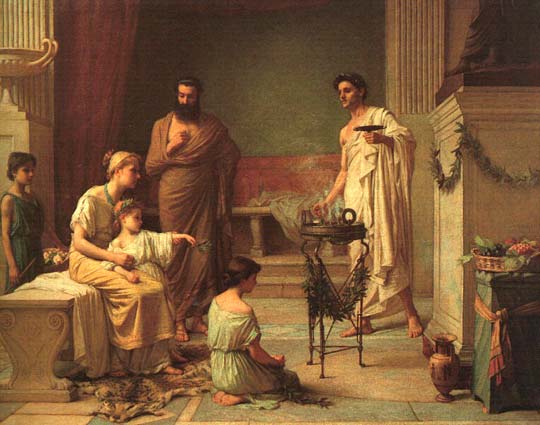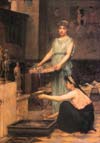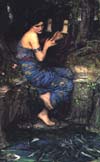
|
 1877 . Oil on canvas
1877 . Oil on canvas
 The Fine Art Society
The Fine Art Society
Actual Size (W x H): 208cm x 170cm [ 81.95" x 66.98" ]
 John William Waterhouse: A Sick Child brought into the Temple of Aesculapius - 1877
John William Waterhouse: A Sick Child brought into the Temple of Aesculapius - 1877
» View Larger Scan
» Create As Calendar
Aesculapius In Greek mythology, Aesculapius, son of Apollo, (often referred to as the god of medicine or healing) was a Greek healer who became a Greek demigod, and was a famous physician. His mother, the nymph Coronis, a princess of Thessaly, died when he was an infant. Aesculapius was the most important among the Greek gods and heroes who were associated with health and curing disease.
Apollo is said to have entrusted the child's education to the Centaur, Chiron. who taught Aesculapius the arts of healing.
Aesculapius, when grown, became so skilled in surgery and the use of medicinal plants that he could even restore the dead to life. Hades, ruler of the dead, became alarmed at this and complained to Zeus, who, fearing that he might render all men immortal, killed Asclepius with a thunderbolt. Among the children of Aesculapius the best known are his daughters Hygeia and Panacea.
Asclepius, or Aesculapius as he was known to the Romans, was revered as a divinely inspired physician. Shrines and temples of healing known as Asclepieia were erected throughout Greece where the sick would come to worship and seek cures for their ills. Harmless serpents were kept in these temples of healing, lovingly tended by Asclepiu's daughter Hygeia, the personification of health. Snakes were held sacred by Asclepius and he himself was thought to sometimes appear in the form of a snake. Patients who saw snakes in their dreams believed that the god of healing himself had come to their aid.
The ancient symbol of Asclepius is a knotted wooden staff around which a mystical snake is coiled. The staff of Aesculapius with a coiled serpent became the traditional symbol of medicine. Today it represents the modern medical profession, and is a symbol of health and wisdom. In Genesis, Moses held up a serpent on a staff as an example of Christ, to heal the Jews.
View the real temple
aoeta.org
© Image Copyright and Reproduction Information
|
|

 I think so Brain, but if Jimmy cracked corn, and no one cares, why does he keep doing it? - Pinky
I think so Brain, but if Jimmy cracked corn, and no one cares, why does he keep doing it? - Pinky

 Current Waterhouse Posters Promotion
Current Waterhouse Posters Promotion

|
|
 |



![Ophelia [blue dress] (1905)](/paintings/thumbs_full/waterhouse_ophelia_03.jpg)



 I think so Brain, but if Jimmy cracked corn, and no one cares, why does he keep doing it? - Pinky
I think so Brain, but if Jimmy cracked corn, and no one cares, why does he keep doing it? - Pinky
 Current Waterhouse Posters Promotion
Current Waterhouse Posters Promotion
